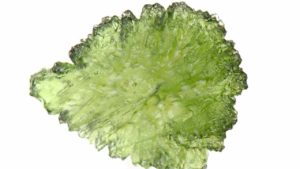What is the spiritual meaning of prehnite?
Prehnite is a gemstone often associated with spiritual growth, inner peace, and harmony. Its soft green color symbolizes renewal and rejuvenation, connecting it to the heart chakra and the energy of love, compassion, and forgiveness. In spiritual practices, it enhances one’s ability to connect with higher realms and divine energies, making it a stone of intuition and spiritual insight.
Prehnite gemstone is also linked to the concept of serenity and calmness. Its gentle energy encourages a sense of tranquility and balance, making it beneficial for meditation and mindfulness. It helps to release negative emotions, anxieties, and worries, fostering a state of clarity and mental clarity.
Moreover, it is often associated with healing and protection. It acts as a shield against negativity and help create a protective barrier around the aura, allowing one to maintain their own energy boundaries. The gemstone’s energy promotes self-discovery and self-acceptance, promoting a deeper understanding of one’s true self and purpose.
What is the benefit of prehnite stone?
Prehnite is a unique gemstone that offers several benefits to those who work with its energies. Its gentle green hue resonates with promoting emotional healing, compassion, and harmony. This gemstone is known to enhance intuition and spiritual awareness, facilitating a deeper connection with one’s inner self and higher realms. Prehnite’s calming and soothing energy helps alleviate stress, anxiety, and restlessness, fostering a sense of peace and balance.
One of its key benefits is aiding in personal growth and self-discovery. It encourages self-reflection and self-acceptance, enabling individuals to better understand their motivations and desires. It also acts as a protective shield, preventing negative energies from affecting one’s aura. In relationships, It promotes open communication and supports healing in emotional wounds. Overall, the stone is a versatile and transformative crystal that offers emotional, spiritual, and energetic advantages to those who incorporate it into their practices and lives.

Is prehnite worn on the left or right hand?
There is no strict rule regarding whether prehnite should be worn on the left or right hand. The choice of which hand to wear a crystal on can vary based on personal preference, cultural beliefs, and the specific intentions you have for the crystal.
In some spiritual traditions, the left hand is associated with receiving and passive energies, while the right hand is associated with giving and active energies.
If you’re seeking to enhance your intuitive and receptive qualities, wearing it on the left hand might be preferable. If you’re looking to project or share the energies of the crystal, wearing it on the right hand could be a choice.
Trust your intuition and choose the hand that feels most aligned with your intentions and personal energy.
What other gemstones pairs best with prehnite gemstone?
Prehnite can be beautifully complemented by various gemstones, enhancing its energies and creating harmonious combinations.
One great pairing is Amethyst, known for its spiritual insight and calming properties. The combination of Prehnite’s heart-centered energy with Amethyst’s higher consciousness can aid in emotional healing and spiritual growth.
Another suitable match is Rose Quartz, a stone of unconditional love and compassion. When combined with the gemstone, it can create a powerful synergy for self-love, inner healing, and nurturing relationships.
For those seeking grounding and stability, Smoky Quartz pairs well with Prehnite. Smoky Quartz’s protective and anchoring qualities can help balance Prehnite’s more ethereal energy.
Additionally, Clear Quartz can amplify and clarify the effects of Prehnite, enhancing its spiritual properties and overall energy.
Can prehnite get wet?
It is generally safe to come into contact with water, but prolonged exposure to water or harsh chemicals might affect its appearance and polish over time. To preserve its beauty, it’s advisable to remove Prehnite jewelry before swimming, bathing, or doing household chores involving water.
After brief contact, gently pat it dry to prevent any potential water spots. While it won’t be immediately damaged by water, it’s still a good practice to treat it with care and avoid excessive exposure to moisture to maintain its quality and luster.
Is prehnite always green?
It is most commonly known for its pale to medium green color, which can vary in intensity and shade. However, it’s important to note that prehnite can also occur in other colors, although these variations are relatively rare. Some examples of color variations include yellow, white, gray, and even colorless. These alternate colors are typically caused by different minerals present in the gemstone’s formation.
While green is the most recognizable and prevalent color for prehnite, the occurrence of other colors adds to its uniqueness and versatility, allowing individuals to connect with the stone’s energies through different visual and energetic experiences.
Is prehnite a crystal or gemstone?
Prehnite is generally referred to as a mineral, which means it’s a naturally occurring inorganic solid that has a specific chemical composition and a defined crystal structure. However, in the context of metaphysical and spiritual practices, “crystal” and “gemstone” are often used interchangeably to refer to various minerals, gemstones, and crystals that possesses certain energies and properties. So, while prehnite is technically a mineral, it is also commonly referred to as a crystal or gemstone in these contexts due to its use in healing, meditation, and spiritual work.
What is the difference between prehnite and jade?
Prehnite and jade are distinct gemstones with differing appearances, mineral compositions, and historical significance. Prehnite is characterized by its pale to medium green color, occasionally found in shades of yellow, white, or gray. It typically possesses a translucent to semi-translucent quality, and it’s known for its associations with heart-centered energies, emotional healing, and spiritual growth. Prehnite’s energy promotes inner peace and intuition, making it a sought-after choice for meditation and holistic practices.
Jade, on the other hand, is a dense and durable gemstone that comes in two primary types: nephrite and jadeite. Nephrite jade is often found in shades of green, white, or grey, while jadeite can exhibit a wider range of colors including green, lavender, red, and more. Jade has deep cultural significance in various civilizations and is renowned for its protective and fortunate properties. It’s treasured for its toughness and is often used in carvings, jewelry, and ornamental pieces. Jade has been revered in many cultures for millennia and holds a special place in history due to its rich symbolism and artistry.
Read next: Moldavite: Infuse the High-Vibe Energy from The Alien Gemstone!




